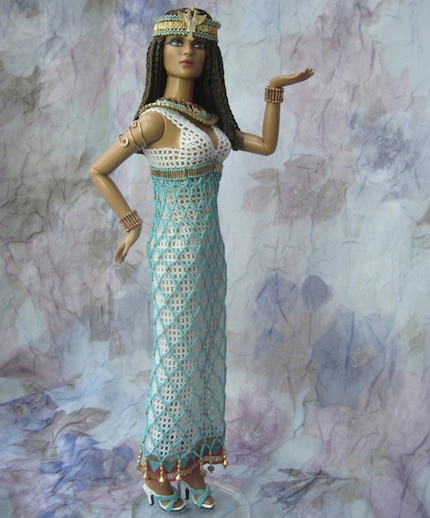
Another stunning doll I found on Etsy is this hand-beaded Ahotep Ancient Egyptian Doll produced by JuliesBeadedElements. The diamond-patterned turquoise gown overlay looks very similar to actual beaded burial shrouds I have seen in the Egyptian galleries of the Metropolitan Museum of Art:
"This doll was formerly a Tonner, Jac doll. I have removed all of her original face paint, and re-painted her face with artist quality, Golden, paints and sealers. I carefully sectioned, and braided her hair in the ancient Egyptian wig style, however, it is her rooted hair that I braided, and not a wig. Each braid is fully knotted with fireline thread that will not degrade over time.
The layered gown is constructed completely with beads, treated thread, and fireline. The beads that are used in this garment are gold plated brass, glass Czech beads, Delica seed beads, and gold plated seed beads. This gown is not removable, it
 has been woven to fit her body, and does not stretch at all. This also means that the weight of the beads will not stretch out the garment. The base of the gown was created with a right angle weave, and the outer layer was woven in a netting weave. The bottom panel is constructed using a peyote stitch, done in a traditional, ancient Egyptian, geometric pattern.
has been woven to fit her body, and does not stretch at all. This also means that the weight of the beads will not stretch out the garment. The base of the gown was created with a right angle weave, and the outer layer was woven in a netting weave. The bottom panel is constructed using a peyote stitch, done in a traditional, ancient Egyptian, geometric pattern.The headband is removable, and has an Egyptian, Phoenix symbol on it that is gold plated. The woven bead bracelets are not removable. The arm band is made of gold filled wire. The beaded shoes, doll and stand are all included with this sale. Also included is a signed, ceritificate of authenticity."
Julie, a mother of five, has worked as a jewelry designer in Chicago as well as a clothing designer and manager of a custom clothing store:
"Ever since I can remember- I have been creating something. I studied different forms of art expression, and majored in fashion design in college. Being juried into a national gallery exhibit when I was 16 gave me the motivation to continue as a serious artist from a young age. My work profile includes working as a jewelry designer for a prestigious jeweler in Water Tower Place, Chicago. My additional experience includes working as a custom clothing designer/trainer (also on the magnificent mile) and as the manager of a custom clothing store.
Currently, I teach beadwork techniques, and jewelry-making techniques in my small bead shoppe. My experience with expecting, and presenting quality has lead me on to be very concerned with making a work of art that is nothing less than beautiful, durable, and unique.
I have won design contests for my beaded art, most notably a gold medal win in a recent international beading contest. "